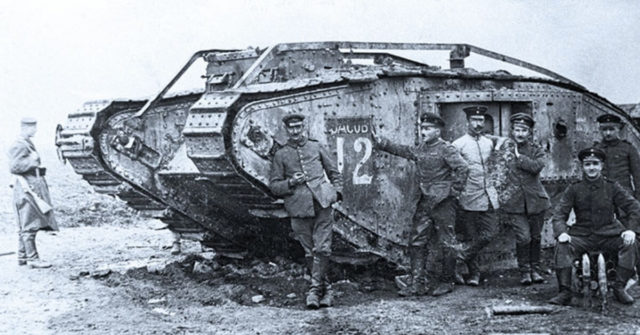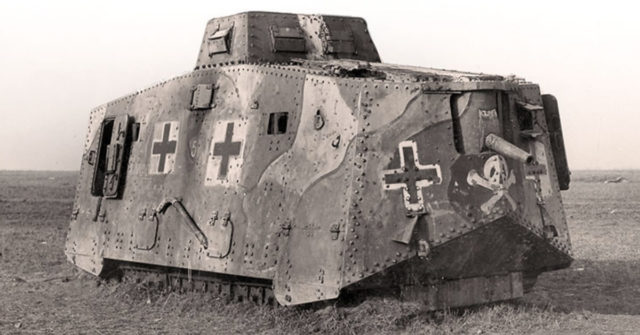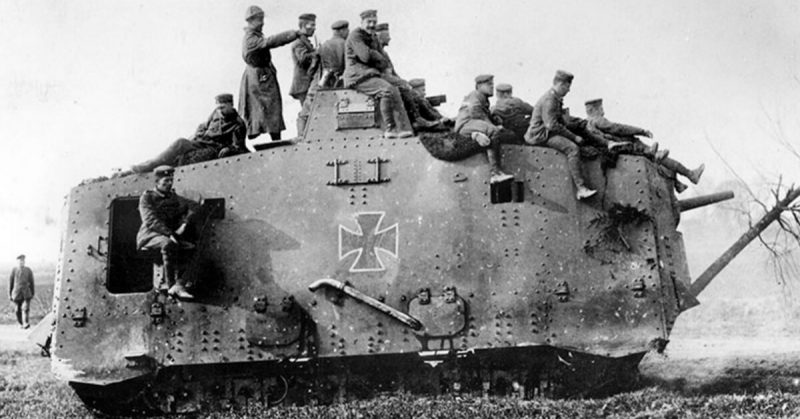The British Mk I tank was unleashed during the Battle of The Somme in September 1916 – but the Germans were much slower to develop an armored fighting vehicle of their own: the A7V.
Whereas British strategists were eager to conceive and deploy some kind of `land ship` as soon as the war reached a stalemate in 1914, there seemed to be less enthusiasm for the concept amongst the German General Staff. Even after the first British tank attack, they prioritized the development of anti-tank tactics and weapons.
This may be due to the fact that the tank was an offensive weapon and the Germans were, with one important exception, effectively engaged in a defensive war. But the appearance of the Mk I did force a German response. That same month a unit was set up to design and build the first German tank.
The First A7V
The first pre-production model of the new tank was complete a year later. In appearance, it was more `land ship` than its British counterpart; an armored box on tracks bristling with weaponry. With a crew of 18, it required 10 more men than a British tank. There were two men for each of the 6 machine guns, two for the 57mm gun at the front, a driver, a signaller, a mechanic and the commanding officer. 24ft long, 10ft wide, and almost 11ft high, with two powerful engines and armor plate that varied between 30mm at the front and 15mm at the sides, it weighed 33 tons and could travel at 4mph across country.
It was a promising start from a nation that would come to lead the world in tank design twenty years later. Like those later German tank designs the A7V was superbly engineered; far in advance of the British machines in their quality and mechanical sophistication. And just like some of those later designs, that sophistication would also prove to be what undermined it the most. Whilst 100 A7V’s were ordered, only 20 were built and they didn’t arrive on the frontline until March 1918. Their numbers would be dwarfed by the quantity of armor the British and French were putting into the field.
Beutepanzers

Meanwhile, in late 1917, around 40 British Mark IVs were captured and put into service with the German Army. The new German Tank Companies were fighting first in British hardware – and the Mk IV would remain the most numerous tank in German service.
It has been suggested that German crews preferred the Mark IV. It may have been a less sophisticated vehicle, but it was far better suited to the ruling conditions on the Western Front. Whilst the A7V performed much better on open terrain, its high center of gravity and low ground clearance meant it struggled to cross the muddy, pock-marked ground found in its intended area of operation.
A7V vs. Mark IV
The real test of a tank’s performance comes in battle. At the Second Battle of Villers-Bretonneaux, on 24 April 1918, the Germans used as many as 15 A7V’s across a four-mile front. Some estimates suggest that by the end of the battle they had lost half to a combination of capture, battle damage, ditching, or breakdown. In places, they were successful, with at least one British unit reporting that their lines had been breached by tanks. But what would happen when British tanks met German tanks in battle?
That’s exactly what occurred on the opening day of Villers-Bretonneaux, as a group of three advancing A7V’s unexpectedly encountered three British Mark IV’s. Two of the British Mark IV’s were `female` (armed only with machine guns for infantry support) and were unable to damage their opponents and forced to withdraw when the A7V’s engaged and damaged them with armor-piercing rounds.

The remaining Mark IV `male`, commanded by Second Lieutenant Frank Mitchell, managed to score three direct 6 pounder hits on the lead German A7V. These set it ablaze and toppled it into a shell hole. The crew fled on foot. Mitchell then turned his guns on the remaining A7V’s, later reporting that they withdrew after he had fired several ranging shots at them. Mitchell continued to engage the advancing Infantry but by then he had gained the attention of enemy artillerymen. His tank was disabled by a mortar, but he and his crew escaped.
Aftermath
The first tank vs tank engagement was a messy encounter, but it is reasonable to attribute victory to the Mk IV. Of course, both tank designs are poor by modern standards, but even in 1918, the Germans did not consider the A7V to be practical. It was too big, too ungainly, too expensive, and needed too many men to crew it. German designers went back to the drawing board – and some far more promising designs were being advanced when the war came to an end.
A message from the Tank Museum:
“Please Support Us: As a charity, we rely on public support for all our activities. Our work is funded entirely by people like you. With your support, we can continue to create content. With the right support we might be able to do it more regularly – and can be even more ambitious. Please Click on the Banner Below”
Thanks to the Tank Museum for this Blog, which originally appeared here.

